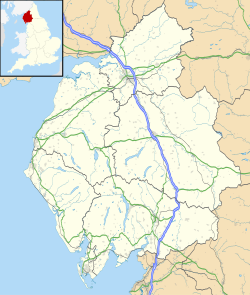St Mary's Church, Ambleside: Difference between revisions
m wl |
m Robot - Speedily moving category 19th-century Church of England churches to Category:19th-century Church of England church buildings per CFDS. |
||
| Line 104: | Line 104: | ||
[[Category:Gothic Revival architecture in Cumbria]] |
[[Category:Gothic Revival architecture in Cumbria]] |
||
[[Category:Diocese of Carlisle]] |
[[Category:Diocese of Carlisle]] |
||
[[Category:19th-century Church of England |
[[Category:19th-century Church of England church buildings]] |
||
Revision as of 19:30, 2 January 2018
| St Mary's Church | |
|---|---|
 | |
| 54°25′51″N 2°58′00″W / 54.430848°N 2.966588°W | |
| Location | Ambleside |
| Country | United Kingdom |
| Denomination | Church of England |
| Website | amblesidechurch.org.uk |
| Architecture | |
| Heritage designation | Grade II* |
| Architect(s) | George Gilbert Scott |
| Style | Gothic Revival |
| Years built | 1850s |
| Administration | |
| Province | York |
| Diocese | Carlisle |
| Archdeaconry | Westmorland |
| Clergy | |
| Bishop(s) | James Newcome |
| Pastor(s) | Beverley Lock |
St Mary's Church is in Ambleside, Cumbria, England. It was built in the 1850s to a design by George Gilbert Scott in Gothic Revival style (specifically Decorated Gothic). The building is Grade II* listed.[1] Notable features include its stone spire, which is a local landmark and an unusual feature in Lake District churches.[2][3]
The building is constructed of slate, the typical building stone of the locality, and sandstone which is used for dressings and the spire.
History
The decision to build the church reflects the coming of the railway to Windermere in 1847 and the subsequent expansion of Ambleside.
A north-east choir vestry was added in 1889 to the designs of Paley & Austin of Lancaster.[1]
Interior
Wall-painting
There is a 26-foot mural on the west wall depicting rushbearing (a traditional ceremony in Ambleside which is held on the first Saturday in July).[4] The mural was created by Gordon Ransom of the Royal College of Art when the College was evacuated to Ambleside during the Second World War.[1][5] The vicar of Ambleside, Henry Adamson Thompson, is depicted on the right hand side of the mural.
Burials
Burials include Mary Louisa Armitt, the founder of Ambleside's Armitt Library.[6] Her sisters Annie and Sophia are also buried there.
References
- ^ a b c "Church of St Mary". Historic England. Retrieved 2017-08-01.
- ^ Bingham, Roger (2011). "Guide book reveals". Westmorland Gazette. Retrieved 16 March 2014.
- ^ St Mary's Church. www.visitcumbria.com
- ^ "Fundraising begins to restore historical Lake District mural". Westmorland Gazette. Retrieved 2017-08-02.
- ^ Leslie Duxbury (2008), Bohemians in Exile: The Royal College of Art in Ambleside, 1940-1945. "Bohemians in Exile" was also the title of a 2011 exhibition at the Armitt Museum.
- ^ Eileen Jay, ‘Armitt, Mary Louisa (1851–1911)', Oxford Dictionary of National Biography, Oxford University Press, 2004. Accessed 2017-08-02 (subscription or UK public library membership required)

